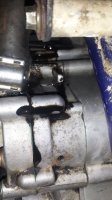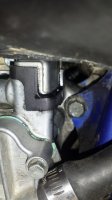Hey guys so I rebuilt my 03 yz125, top and bottom. I ran the bike but I just seen this and I'm curious if anyone knows where the black spooge is coming from and why? Thanks for your guys help, much appreciated. The pics look like the power valve rubber gasket thing and the other pic looks like somewhere by the water pump maybe.
You are using an out of date browser. It may not display this or other websites correctly.
You should upgrade or use an alternative browser.
You should upgrade or use an alternative browser.
yz125 help
- Thread starter neen
- Start date
Hey guys so I rebuilt my 03 yz125, top and bottom. I ran the bike but I just seen this and I'm curious if anyone knows where the black spooge is coming from and why? Thanks for your guys help, much appreciated. The pics look like the power valve rubber gasket thing and the other pic looks like somewhere by the water pump maybe.
That might just be residual oil from assembly. Once you have a couple of heat cycles in go rip some really hot laps(about 5laps at 11,000rpm) that should start clearing out the assembly oil. You'll know it's burning off because your silencer will smoke after you shut the bike down. After doing that a couple times wipe the motor clean and repackage the silencer.
Or maybe that's where cool
Ya it's also coming out of the rubber thing that holds the fatty with the mufflerThat might just be residual oil from assembly. Once you have a couple of heat cycles in go rip some really hot laps(about 5laps at 11,000rpm) that should start clearing out the assembly oil. You'll know it's burning off because your silencer will smoke after you shut the bike down. After doing that a couple times wipe the motor clean and repackage the silencer.
if you dont have that taken care of by the time you have been riding it normally for an hour, set the carburetor float and see how it is. if that sounds foreign, i wont be surprised.
You know where I'm going with this.

Cool Thanks guys. Can you also educate me a bit on the air screw and idle screw and how I should set thoseI am all "atwitter". I am waiting on your "Dad's" comments too of course
I like to set the low speed screw 1.5 turns out from lightly seated. i turn the idle screw in until it will run on its own. Then I turn the airscrew out until it idles it's fastest. If I think I am going to be riding down lots of downhills in gear I leave it there. Usually I get it to its fastest and play back and forth with it to find that spot at high idle where you can turn a little bit one way or the other and you can tell no difference. I leave it at the rich end of that sweet spot and then readjust my idle back to where I want it.
All that is completely wasted and like pissing in the wind if you don't set the float first and have good clean jets. If your air cleaner isn't fairly clean and free from whatever you used to clean it in, take it off. Makes little difference at low speeds.
All that is completely wasted and like pissing in the wind if you don't set the float first and have good clean jets. If your air cleaner isn't fairly clean and free from whatever you used to clean it in, take it off. Makes little difference at low speeds.
For OP:
Did you replace the power valve seals during this rebuild?
Also:
I will usually take my map-gas torch and burn the exhaust chamber for a good amount of time to insure the old carbon and oils are sufficiently gone upon re-assemble.
For M33:
Good point.
And:
I know where you are going with it every time.
For ogp:
What does a float level have to do with oil/spooge coming from the locations OP mentioned?
For OP:
Air screw should be set factory and then fiddled from there. Add additional jetting changes and fiddle some more.
For ogp:
Even putting the bike at factory settings or your recommendations he will need to fiddle. The thing about the smaller CC 2T bikes are they are not all the same, everyone doesn't live next to you (as in altitude, humidity, etc.) so what works at sea level, will not work at higher elevations. But you know that already.
M33, daddy.
Did you replace the power valve seals during this rebuild?
Also:
I will usually take my map-gas torch and burn the exhaust chamber for a good amount of time to insure the old carbon and oils are sufficiently gone upon re-assemble.
For M33:
Good point.
And:
I know where you are going with it every time.
For ogp:
What does a float level have to do with oil/spooge coming from the locations OP mentioned?
For OP:
Air screw should be set factory and then fiddled from there. Add additional jetting changes and fiddle some more.
For ogp:
Even putting the bike at factory settings or your recommendations he will need to fiddle. The thing about the smaller CC 2T bikes are they are not all the same, everyone doesn't live next to you (as in altitude, humidity, etc.) so what works at sea level, will not work at higher elevations. But you know that already.
M33, daddy.
Short answer Palm is I know that engine pretty well. There is a casting that runs right under the exhaust port. Runs right over and dumps spooge right on the TOP of that rubber seal block. Just like I see in the pic. Take a peep and you will see it looks like a rain gutter. Way more likely than having it swim back upstream unarrested by a torch. Glad you asked.
Your second paragraph to me seemed like you must have missed the intent of my post on how I adjust a carburetor. Please know I adjust them often and have done it the way it has worked best for me in temp swings from 40 below to 100 plus. I live at sea level but have ones set up for 7500 feet and have set up for Pikes Peak. (You don't ride over 12-14k I bet.) I don't think I said anything to make anyone believe there won't be some playing around. Note the sweet spot comment. OP asked about setting the low speed screw and the idle. It's what I adressed.
Your second paragraph to me seemed like you must have missed the intent of my post on how I adjust a carburetor. Please know I adjust them often and have done it the way it has worked best for me in temp swings from 40 below to 100 plus. I live at sea level but have ones set up for 7500 feet and have set up for Pikes Peak. (You don't ride over 12-14k I bet.) I don't think I said anything to make anyone believe there won't be some playing around. Note the sweet spot comment. OP asked about setting the low speed screw and the idle. It's what I adressed.
Last edited:
I like to set the low speed screw 1.5 turns out from lightly seated. i turn the idle screw in until it will run on its own. Then I turn the airscrew out until it idles it's fastest. If I think I am going to be riding down lots of downhills in gear I leave it there. Usually I get it to its fastest and play back and forth with it to find that spot at high idle where you can turn a little bit one way or the other and you can tell no difference. I leave it at the rich end of that sweet spot and then readjust my idle back to where I want it.
All that is completely wasted and like pissing in the wind if you don't set the float first and have good clean jets. If your air cleaner isn't fairly clean and free from whatever you used to clean it in, take it off. Makes little difference at low speeds.
After a 2nd look at the pic this one would be a good candidate for setting the float.
 rebuilds shoul go hand in hand with setting floats. There's a sticky here someplace with correct float settings.
rebuilds shoul go hand in hand with setting floats. There's a sticky here someplace with correct float settings.Found it:
https://www.dirtbikeaddicts.com/content/threads/dirt-bike-jetting-101.5692/#post-44746
Last edited:
the weak spot with yamaha and their manual for setting carburetors, the float in particular is how they state "ranges". people read that and think they can have a range of say 2.3 mm and that it will yield the same effective jetting no matter where in that range the level falls. not the case. It is also the strong spot to others. Yamaha does a real service to a person who is trying to actually "tune" the engine. That is a range that the carburetor can function properly in, ie not flood and not be so low when the bike is on level ground that it is likely to start sucking air into the jets instead of fuel. that leaves the owner or tuner etc to pick the part of the range he wants to maintain or jet for, and to know what range he can use to affect an across the board change in. The smart ones have specific jetting for temps and altitudes that go with each segment of that range in most cases.


